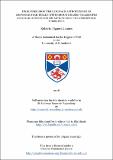Files in this item
High-precision time-domain astrophysics in crowded star-fields with ground based telescopes : globular clusters and the mitigation of the atmospheric turbulence
Item metadata
| dc.contributor.advisor | Horne, K. (Keith) | |
| dc.contributor.author | Figuera Jaimes, Roberto Jose | |
| dc.coverage.spatial | xxii, 107 p. | en_US |
| dc.date.accessioned | 2018-06-01T15:28:52Z | |
| dc.date.available | 2018-06-01T15:28:52Z | |
| dc.date.issued | 2018-05-04 | |
| dc.identifier.uri | https://hdl.handle.net/10023/13673 | |
| dc.description.abstract | We carried out a three year (2013-2015) observational campaign at the Danish 1.54-m Telescope at the ESO observatory at La Silla in Chile in which we obtained ~1000 astronomical images in the field of 11 Galactic globular clusters. The selection of these stellar systems was focused mainly on the visibility of the targets and their relevant physical properties available in the catalogues, among them were considered the density, variable stars known, colour-magnitude diagrams, and luminosity. The telescope was equipped with an electron-multiplying CCD (EMCCD) with the aim of taking very short exposure-time images. The camera was configured to take 10 frames per second. Due to this, the brighter stars observed were not affected by saturation, it helped to give higher signal to noise ratio to the fainter stars and, importantly, it minimised the effects of the atmospheric turbulence such as blending between stars in the crowded fields. To produce normal-exposure-time images (minutes) we implemented the shift-and-add technique that also enabled us to produce images with better angular resolution than previously achieved with conventional CCDs on ground-based telescopes, and even enabled us to produce images with angular resolution close to that obtained with space telescopes. The detection of the stars in each of the globular clusters and the photometry was performed via difference image analysis by using the DanDIA pipeline whose procedures and mathematical techniques have been demonstrated to produce high-precision time-series photometry of very crowded stellar regions. We produced time-series photometry for ~15000 stars in the fields observed which were statistically analysed in order to automatically extract variable stars. Our aim is to complete, or improve, the census of the variable star population in the globular clusters. In NGC 6715, we found light curves for 17 previously known variable stars near the edges of our reference image (16 RR Lyrae and 1 semi-regular) and we discovered 67 new variables (30 RR Lyrae, 21 long-period irregular, 3 semi-regular, 1 W Virginis, 1 eclipsing binary, and 11 unclassified). This cluster was particularly interesting because apart from the results obtained, it shows the benefits of using the EMCCD cameras and the shift-and-add technique. It is a cluster studied several times including data obtained with the OGLE survey and also with the Hubble Space Telescope and our discoveries were still new. Our new RR Lyrae star discoveries help confirm that NGC 6715 is of intermediate Oosterhoff type. In the other 10 globular clusters, we obtained light curves for 31 previously known variable stars (3 L, 2 SR, 20 RR Lyrae, 1 SX Phe, 3 cataclysmic variables, 1 EW and 1 NC) and we discovered 30 new variables (16 L, 7 SR, 4 RR Lyrae, 1 SX Phe and 2 NC). In NGC 6093, we analysed the famous case of the 1860 Nova, for which no observations of the Nova in outburst have been made until the present study. Ephemerides and photometric measurements for the variable stars are available in electronic form through the Strasbourg Astronomical Data Centre. | en_US |
| dc.language.iso | en | en_US |
| dc.publisher | University of St Andrews | |
| dc.rights | Attribution-NonCommercial-NoDerivatives 4.0 International | * |
| dc.rights.uri | http://creativecommons.org/licenses/by-nc-nd/4.0/ | * |
| dc.subject | Globular clusters | en_US |
| dc.subject | Crowded star fields | en_US |
| dc.subject | EMCCD | en_US |
| dc.subject | Lucky imaging | en_US |
| dc.subject | Variable stars | en_US |
| dc.subject.lcsh | Astrophysics--Observations | en |
| dc.subject.lcsh | Stars--Globular clusters | en |
| dc.subject.lcsh | Astronomical photometry | en |
| dc.title | High-precision time-domain astrophysics in crowded star-fields with ground based telescopes : globular clusters and the mitigation of the atmospheric turbulence | en_US |
| dc.type | Thesis | en_US |
| dc.contributor.sponsor | Scottish Universities Physics Alliance (SUPA) | en_US |
| dc.type.qualificationlevel | Doctoral | en_US |
| dc.type.qualificationname | PhD Doctor of Philosophy | en_US |
| dc.publisher.institution | The University of St Andrews | en_US |
| dc.publisher.department | European Southern Observatory | en_US |
The following licence files are associated with this item:
This item appears in the following Collection(s)
Except where otherwise noted within the work, this item's licence for re-use is described as Attribution-NonCommercial-NoDerivatives 4.0 International
Items in the St Andrews Research Repository are protected by copyright, with all rights reserved, unless otherwise indicated.


